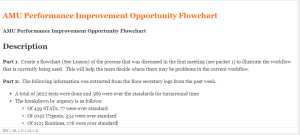AMU Performance Improvement Opportunity Flowchart
Sample Answer for AMU Performance Improvement Opportunity Flowchart Included After Question
Description
Part 1: Create a flowchart (See Lesson) of the process that was discussed in the first meeting (see packet 1) to illustrate the workflow that is currently being used. This will help the team decide where there may be problems in the current workflow.
Part 2: The following information was extracted from the floor secretary logs from the past week.
- A total of 3622 tests were done and 589 were over the standards for turnaround time
- The breakdown by urgency is as follows:
- Of 459 STATs, 77 were over standard
- Of 1042 Urgents, 334 were over standard
- Of 2121 Routines, 178 were over standard
You want to bring a graph of this data for the next team meeting.

NOTE: Your Excel table might look something like this in order to make a graph that will be valuable.
URGENT
ROUTINE
STAT
TOTAL
Number > Standard
334
178
77
589
% of Total > Standard
57%
30%
13%
100%
Cumulative % of Total
57%
87%
100%
TASKS:
- Create a graph, using Excel, depicting the data above. Analyze this data once your graph is made. What conclusions can be drawn? Write a short summary of what the graph is telling you.
Decide! Does the team have enough data? Brainstorm a list of the data you would like to have. Where would you get that data? Submit a shortlist of your brainstorm ideas and explain what you would discuss with the team regarding gathering more
EXAMPLE OF FLOWCHART:
Flowcharts
Procedures and workflows can be mapped and illustrated as a flowchart, in a way that makes it visually easy to understand and remember the workflow. Many people prefer to look at a graphic rather than read a list of statements. This week you are going to practice creating a flowchart which is a very common performance improvement tool.
What is a Process Flowchart?

A Sample Answer For the Assignment: AMU Performance Improvement Opportunity Flowchart
Title: AMU Performance Improvement Opportunity Flowchart
| Excellent | Good | Fair | Poor | ||
| Main Postinga | 45 (45%) – 50 (50%)
Answers all parts of the discussion question(s) expectations with reflective critical analysis and synthesis of knowledge gained from the course readings for the module and current credible sources.
Supported by at least three current, credible sources.
Written clearly and concisely with no grammatical or spelling errors and fully adheres to current APA manual writing rules and style. |
40 (40%) – 44 (44%)
Responds to the discussion question(s) and is reflective with critical analysis and synthesis of knowledge gained from the course readings for the module.
At least 75% of post has exceptional depth and breadth.
Supported by at least three credible sources.
Written clearly and concisely with one or no grammatical or spelling errors and fully adheres to current APA manual writing rules and style. |
35 (35%) – 39 (39%)
Responds to some of the discussion question(s).
One or two criteria are not addressed or are superficially addressed.
Is somewhat lacking reflection and critical analysis and synthesis.
Somewhat represents knowledge gained from the course readings for the module.
Post is cited with two credible sources.
Written somewhat concisely; may contain more than two spelling or grammatical errors.
Contains some APA formatting errors. |
0 (0%) – 34 (34%)
Does not respond to the discussion question(s) adequately.
Lacks depth or superficially addresses criteria.
Lacks reflection and critical analysis and synthesis.
Does not represent knowledge gained from the course readings for the module.
Contains only one or no credible sources.
Not written clearly or concisely.
Contains more than two spelling or grammatical errors.
Does not adhere to current APA manual writing rules and style. |
|
| Main Post: Timeliness | 10 (10%) – 10 (10%)
Posts main post by day 3. |
0 (0%) – 0 (0%) | 0 (0%) – 0 (0%) | 0 (0%) – 0 (0%)
Does not post by day 3. |
|
| First Response | 17 (17%) – 18 (18%)
Response exhibits synthesis, critical thinking, and application to practice settings.
Responds fully to questions posed by faculty.
Provides clear, concise opinions and ideas that are supported by at least two scholarly sources.
Demonstrates synthesis and understanding of learning objectives.
Communication is professional and respectful to colleagues.
Responses to faculty questions are fully answered, if posed.
Response is effectively written in standard, edited English. |
15 (15%) – 16 (16%)
Response exhibits critical thinking and application to practice settings.
Communication is professional and respectful to colleagues.
Responses to faculty questions are answered, if posed.
Provides clear, concise opinions and ideas that are supported by two or more credible sources.
Response is effectively written in standard, edited English. |
13 (13%) – 14 (14%)
Response is on topic and may have some depth.
Responses posted in the discussion may lack effective professional communication.
Responses to faculty questions are somewhat answered, if posed.
Response may lack clear, concise opinions and ideas, and a few or no credible sources are cited. |
0 (0%) – 12 (12%)
Response may not be on topic and lacks depth.
Responses posted in the discussion lack effective professional communication.
Responses to faculty questions are missing.
No credible sources are cited. |
|
| Second Response | 16 (16%) – 17 (17%)
Response exhibits synthesis, critical thinking, and application to practice settings.
Responds fully to questions posed by faculty.
Provides clear, concise opinions and ideas that are supported by at least two scholarly sources.
Demonstrates synthesis and understanding of learning objectives.
Communication is professional and respectful to colleagues.
Responses to faculty questions are fully answered, if posed.
Response is effectively written in standard, edited English. |
14 (14%) – 15 (15%)
Response exhibits critical thinking and application to practice settings.
Communication is professional and respectful to colleagues.
Responses to faculty questions are answered, if posed.
Provides clear, concise opinions and ideas that are supported by two or more credible sources.
Response is effectively written in standard, edited English. |
12 (12%) – 13 (13%)
Response is on topic and may have some depth.
Responses posted in the discussion may lack effective professional communication.
Responses to faculty questions are somewhat answered, if posed.
Response may lack clear, concise opinions and ideas, and a few or no credible sources are cited. |
0 (0%) – 11 (11%)
Response may not be on topic and lacks depth.
Responses posted in the discussion lack effective professional communication.
Responses to faculty questions are missing.
No credible sources are cited. |
|
| Participation | 5 (5%) – 5 (5%)
Meets requirements for participation by posting on three different days. |
0 (0%) – 0 (0%) | 0 (0%) – 0 (0%) | 0 (0%) – 0 (0%)
Does not meet requirements for participation by posting on 3 different days. |
|
| Total Points: 100 | |||||

